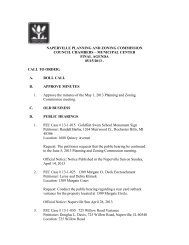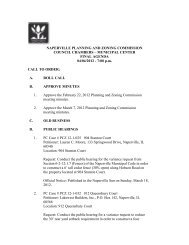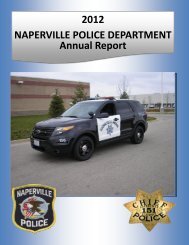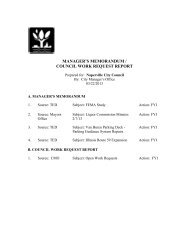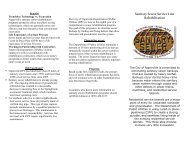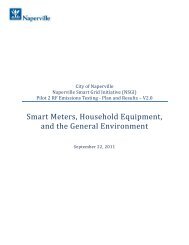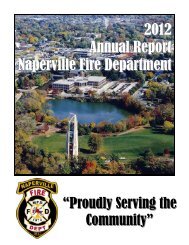The 21st Century Grid - City of Naperville
The 21st Century Grid - City of Naperville
The 21st Century Grid - City of Naperville
Create successful ePaper yourself
Turn your PDF publications into a flip-book with our unique Google optimized e-Paper software.
By Joel Achenbach<strong>The</strong> <strong>21st</strong> <strong>Century</strong> <strong>Grid</strong>Can we fix the infrastructure that powers our lives?Published: July 2010We are creatures <strong>of</strong> the grid. We are embedded in it and empowered by it. <strong>The</strong> sun usedto govern our lives, but now, thanks to the grid, darkness falls at our convenience.During the Depression, when power lines first electrified rural America, a farmer inTennessee rose in church one Sunday and said—power companies love this story—"<strong>The</strong>greatest thing on earth is to have the love <strong>of</strong> God in your heart, and the next greatestthing is to have electricity in your house." He was talking about a few lightbulbs andmaybe a radio. He had no idea.Juice from the grid now penetrates every corner <strong>of</strong> our lives, and we pay no moreattention to it than to the oxygen in the air. Until something goes wrong, that is, andwe're suddenly in the dark, fumbling for flashlights and candles, worrying about thefrozen food in what used to be called (in pre-grid days) the icebox. Or until the batteriesrun dry in our laptops or smart phones, and we find ourselves scouring the dustycorners <strong>of</strong> airports for an outlet, desperate for the magical power <strong>of</strong> electrons.<strong>The</strong> grid is wondrous. And yet—in part because we've paid so little attention to it,engineers tell us—it's not the grid we need for the <strong>21st</strong> century. It's too old. It's reliablebut not reliable enough, especially in the United States, especially for our mushroomingpopulation <strong>of</strong> finicky digital devices. Blackouts, brownouts, and other power outs costAmericans an estimated $80 billion a year. And at the same time that it needs tobecome more reliable, the grid needs dramatic upgrading to handle a different kind <strong>of</strong>power, a greener kind. That means, among other things, more transmission lines tocarry wind power and solar power from remote places to big cities.Page 1 <strong>of</strong> 10
Most important, the grid must get smarter. <strong>The</strong> precise definition <strong>of</strong> "smart" varies fromone engineer to the next. <strong>The</strong> gist is that a smart grid would be more automated andmore "self-healing," and so less prone to failure. It would be more tolerant <strong>of</strong> smallscale,variable power sources such as solar panels and wind turbines, in part because itwould even out fluctuations by storing energy—in the batteries <strong>of</strong> electric cars,according to one speculative vision <strong>of</strong> the future, or perhaps in giant caverns filled withcompressed air.But the first thing a smart grid will do, if we let it, is turn us into savvier consumers <strong>of</strong>electricity. We'll become aware <strong>of</strong> how much we're consuming and cut back, especially atmoments <strong>of</strong> peak demand, when electricity costs most to produce. That will save us andthe utilities money—and incidentally reduce pollution. In a way, we'll stop being merepassive consumers <strong>of</strong> electrons. In the <strong>21st</strong> century we'll become active participants inthe management <strong>of</strong> this vast and seemingly unknowable network that makes ourcivilization possible.So maybe it's time we got to know it.<strong>The</strong>re are grids today on six continents, and someday Europe's may reach across theMediterranean into Africa to carry solar power from the Sahara to Scandinavia. InCanada and the U.S. the grid carries a million megawatts across tens <strong>of</strong> millions <strong>of</strong> miles<strong>of</strong> wire. It has been called the world's biggest machine. <strong>The</strong> National Academy <strong>of</strong>Engineering calls it the greatest engineering achievement <strong>of</strong> the last century.Thomas Edison, already famous for his lightbulb, organized the birth <strong>of</strong> the grid in 1881,digging up lower Manhattan to lay down copper wires inside brick tunnels. Heconstructed a power plant, the Pearl Street Station, in the shadow <strong>of</strong> the BrooklynBridge. On September 4, 1882, in the <strong>of</strong>fice <strong>of</strong> tycoon J. P. Morgan, Edison threw aswitch. Hundreds <strong>of</strong> his bulbs lit up Drexel, Morgan & Co. and other <strong>of</strong>fices nearby.Edison was heavily invested in direct current, which worked well in his bulbs and whichat the time was low voltage. Alternating current, he argued colorfully, was moreappropriate to executing criminals. (He had a circus elephant electrocuted to prove hispoint.) <strong>The</strong> argument was misleading: AC, in which the electrons don't stream in onedirection but oscillate back and forth at a given frequency, isn't intrinsically morePage 2 <strong>of</strong> 10
dangerous than DC. High voltage is what's dangerous—but it's also what allows power tobe transmitted hundreds <strong>of</strong> miles without excessive loss. AC won out over DC largelybecause it can easily be stepped up with transformers, transmitted, then stepped downagain to a safer household voltage <strong>of</strong> 110 or 220. By the 1890s AC lines were runningfrom the new Niagara Falls generating station to Buffalo, some 20 miles away. <strong>The</strong>sedays, ironically, high-voltage DC is sometimes preferred for very long distances; it'sharder to produce than AC, but it loses even less power.It took decades for electricity to expand from factories and mansions into the homes <strong>of</strong>the middle class. In 1920 electricity still accounted for less than 10 percent <strong>of</strong> the U.S.energy supply. But inexorably it infiltrated everyday life. Unlike coal, oil, or gas,electricity is clean at the point <strong>of</strong> use. <strong>The</strong>re is no noise, except perhaps a faint hum, noodor, and no soot on the walls. When you switch on an electric lamp, you don't think <strong>of</strong>the huge, sprawling power plant that's generating the electricity (noisily, odoriferously,sootily) many miles away. Refrigerators replaced iceboxes, air conditioners replacedheat prostration, and in 1956 the electric can opener completed our emergence from thedark ages. Today about 40 percent <strong>of</strong> the energy we use goes into making electricity.At first, utilities were local operations that ran the generating plant and the distribution.A patchwork <strong>of</strong> mini-grids formed across the U.S. In time the utilities realized theycould improve reliability and achieve economies <strong>of</strong> scale by linking their transmissionnetworks. After the massive Northeast blackout <strong>of</strong> 1965, much <strong>of</strong> the control <strong>of</strong> the gridshifted to regional operators spanning many states. Yet today there is still no single gridin the U.S.; there are three nearly independent ones—the Eastern, Western, and TexasInterconnections.<strong>The</strong>y function with antiquated technology. <strong>The</strong> parts <strong>of</strong> the grid you come into contactwith are symptomatic. How does the power company measure your electricity usage?With a meter reader—a human being who goes to your home or business and reads thedials on a meter. How does the power company learn that you've lost power? When youcall on the phone. In general, utilities don't have enough instantaneous information onthe flow <strong>of</strong> current through their lines—many <strong>of</strong> those lines don't carry any data—andpeople and slow mechanical switches are too involved in controlling that flow.Page 3 <strong>of</strong> 10
"<strong>The</strong> electrical grid is still basically 1960s technology," says physicist Phillip F. Schewe,author <strong>of</strong> <strong>The</strong> <strong>Grid</strong>. "<strong>The</strong> Internet has passed it by. <strong>The</strong> meter on the side <strong>of</strong> your houseis 1920s technology." Sometimes that quaintness becomes a problem. On the grid thesedays, things can go bad very fast.When you flip a light switch, the electricity that zips into the bulb was created just afraction <strong>of</strong> a second earlier, many miles away. Where it was made, you can't know,because hundreds <strong>of</strong> power plants spread over many states are all pouring their outputinto the same communal grid. Electricity can't be stored on a large scale with today'stechnology; it has to be used instantly. At each instant there has to be a precise balancebetween generation and demand over the whole grid. In control rooms around the grid,engineers constantly monitor the flow <strong>of</strong> electricity, trying to keep voltage and frequencysteady and to avoid surges that could damage both their customers' equipment and theirown.When I flip a switch at my house in Washington, D.C., I'm dipping into a giant pool <strong>of</strong>electricity called the PJM Interconnection. PJM is one <strong>of</strong> several regional operators thatmake up the Eastern grid; it covers the District <strong>of</strong> Columbia and 13 states, from theMississippi River east to New Jersey and all the way down to the Outer Banks <strong>of</strong> NorthCarolina. It's an electricity market that keeps supply and demand almost perfectlymatched—every day, every minute, every fraction <strong>of</strong> a second—among hundreds <strong>of</strong>producers and distributors and 51 million people, via 56,350 miles <strong>of</strong> high-voltagetransmission lines.One <strong>of</strong> PJM's new control centers is an hour north <strong>of</strong> Philadelphia. Last February I wentto visit it with Ray E. Dotter, a company spokesman. Along the way Dotter identified thepower lines we passed under. <strong>The</strong>re was a pair <strong>of</strong> 500-kilovolt lines linking the Limericknuclear plant with the Whitpain substation. <strong>The</strong>n a 230-kilovolt line. <strong>The</strong>n another.Burying the ungainly lines is prohibitively expensive except in dense cities. "<strong>The</strong>re's aneed to build new lines," Dotter said. "But no matter where you propose them, peopledon't want them."Dotter pulled <strong>of</strong>f the turnpike in the middle <strong>of</strong> nowhere. A communications tower pokedabove the treetops. We drove onto a compound surrounded by a security fence. Soon wePage 4 <strong>of</strong> 10
were in the bunker, built by AT&T during the Cold War to withstand anything but adirect nuclear hit and recently purchased by PJM to serve as its new nerve center.In the windowless control room, dominated by a curved wall <strong>of</strong> 36 computer screens,dispatch general manager Mike Bryson explained what I was seeing. A dynamic map onone <strong>of</strong> the screens showed the PJM part <strong>of</strong> the grid. Arrows represented majortransmission lines, each with a number showing how much juice was on the line at thatmoment. Most <strong>of</strong> the arrows pointed west to east: In the eastern U.S. electricity flowsfrom major power plants in the heartland toward huge clusters <strong>of</strong> consumers along theeastern seaboard. At that moment PJM lines were carrying 88,187 megawatts. "Today isa mild winter day—I don't think we'll have over 90,000," Bryson said.<strong>The</strong> computers take data from 65,000 points on the system, he explained. <strong>The</strong>y trackthe thermal condition <strong>of</strong> the wires; too much power flowing through a line can overheatit, causing the line to expand and sag dangerously. PJM engineers try to keep thecurrent alternating at a frequency <strong>of</strong> precisely 60 hertz. As demand increases, thefrequency drops, and if it drops below 59.95 hertz, PJM sends a message to power plantsasking for more output. If the frequency increases above 60.05 hertz, they ask the plantsto reduce output. It sounds simple, but keeping your balance on a tightrope might soundsimple too until you try it. In the case <strong>of</strong> the grid, small events not under the control <strong>of</strong>the operators can quickly knock down the whole system.Which brings us to August 14, 2003. Most <strong>of</strong> PJM's network escaped the disaster, whichstarted near Cleveland. <strong>The</strong> day was hot; the air conditioners were humming. Shortlyafter 1 p.m EDT, grid operators at First Energy, the regional utility, called power plantsto plead for more volts. At 1:36 p.m. on the shore <strong>of</strong> Lake Erie, a power station whoseoperator had just promised to "push it to my max max" responded by crashing.Electricity surged into northern Ohio from elsewhere to take up the slack.At 3:05 a 345-kilovolt transmission line near the town <strong>of</strong> Walton Hills picked thatmoment to short out on a tree that hadn't been trimmed. That failure diverted electricityonto other lines, overloading and overheating them. One by one, like firecrackers, thoselines sagged, touched trees, and short-circuited.Page 5 <strong>of</strong> 10
<strong>Grid</strong> operators have a term for this: "cascading failures." <strong>The</strong> First Energy operatorscouldn't see the cascade coming because an alarm system had also failed. At 4:06 a finalline failure sent the cascade to the East Coast. With no place to park their electricity, 265power plants shut down. <strong>The</strong> largest blackout in North American history descended on50 million people in eight states and Ontario.At the Consolidated Edison control center in lower Manhattan, operators remember thatafternoon well. Normally the power load there dips gradually, minute by minute, asworkers in the city turn <strong>of</strong>f their lights and computers and head home. Instead, at 4?p.m. lights went out in the control room itself. <strong>The</strong> operators thought: 9/11. <strong>The</strong>n thephone rang, and it was the New York Stock Exchange. "What's going on?" someoneasked. <strong>The</strong> operators knew at once that the outage was citywide.<strong>The</strong>re was no stock trading then, no banking, and no manufacturing; restaurants closed,workers were idled, and everyone just sat on the stoops <strong>of</strong> their apartment buildings. Ittook a day and a half to get power back, one feeder and substation at a time. <strong>The</strong>blackout cost six billion dollars. It also alarmed Pentagon and Homeland Security<strong>of</strong>ficials. <strong>The</strong>y fear the grid is indeed vulnerable to terrorist attack, not just tountrimmed trees.<strong>The</strong> blackout and global warming have provided a strong impetus for grid reform. <strong>The</strong>federal government is spending money on the grid—the economic-stimulus packageallocated $4.5 billion to smart grid projects and another six billion dollars or so to newtransmission lines. Nearly all the major utilities have smart grid efforts <strong>of</strong> their own.A smarter grid would help prevent blackouts in two ways. Faster, more detailedfeedback on the status <strong>of</strong> the grid would help operators stay ahead <strong>of</strong> a failure cascade.Supply and demand would also be easier to balance, because controllers would be ableto tinker with both. "<strong>The</strong> way we designed and built the power system over the lasthundred years—basically the way Edison and Westinghouse designed it—we create thesupply side," says Steve Hauser <strong>of</strong> the U.S. Department <strong>of</strong> Energy's National RenewableEnergy Laboratory (NREL) near Boulder, Colorado. "We do very little to controldemand."Page 6 <strong>of</strong> 10
Working with the NREL, Xcel Energy has brought smart grid technology to Boulder.<strong>The</strong> first step is the installation <strong>of</strong> smart meters that transmit data over fiber-optic cable(it could also be done wirelessly) to the power company. Those meters allow consumersto see what electricity really costs at different times <strong>of</strong> day; it costs more to generateduring times <strong>of</strong> peak load, because the utilities have to crank up auxiliary generatorsthat aren't as efficient as the huge ones they run 24/7.When consumers are given a price difference, they can choose to use less <strong>of</strong> theexpensive electricity and more <strong>of</strong> the cheap kind. <strong>The</strong>y can run clothes dryers anddishwashers at night, for instance. <strong>The</strong> next step is to let grid operators choose. Instead<strong>of</strong> only increasing electricity supply to meet demand, the operators could also reducedemand. On sweltering summer days the smart grid could automatically turn upthermostats and refrigerators a bit—with the prior agreement <strong>of</strong> the homeowners <strong>of</strong>course."Demand management" saves energy, but it could also help the grid handle renewableenergy sources. One <strong>of</strong> the biggest problems with renewables like solar and wind poweris that they're intermittent. <strong>The</strong>y're not always available when demand peaks. Reducingthe peak alleviates that problem. You can even imagine programming smart appliancesto operate only when solar or wind power is available.Some countries, such as Italy and Sweden, are ahead <strong>of</strong> the U.S. in upgrading theirelectrical intelligence. <strong>The</strong> Boulder project went online earlier this year, but only about10 percent <strong>of</strong> U.S. customers have even the most primitive <strong>of</strong> smart meters, Hauserestimates."It's expensive," he says. "Utilities are used to spending 40 bucks on an old mechanicalmeter that's got spinning dials. A smart meter with a s<strong>of</strong>tware chip, plus the wirelesscommunication, might cost $200—five times as much. For utilities, that's huge." <strong>The</strong>Boulder project has cost Xcel Energy nearly three times what it expected. Earlier thisyear the utility raised rates to try to recoup some <strong>of</strong> those costs.Although everyone acknowledges the need for a better, smarter, cleaner grid, theparamount goal <strong>of</strong> the utility industry continues to be cheap electricity. In the U.S. abouthalf <strong>of</strong> it comes from burning coal. Coal-powered generators produce a third <strong>of</strong> thePage 7 <strong>of</strong> 10
mercury emissions in America, a third <strong>of</strong> our smog, two-thirds <strong>of</strong> our sulfur dioxide, andnearly a third <strong>of</strong> our planet-warming carbon dioxide—around 2.5 billion metric tons ayear, by the most recent estimate.Not counting hydroelectric plants, only about 3 percent <strong>of</strong> American electricity comesfrom renewable energy. <strong>The</strong> main reason is that coal-fired electricity costs a few cents akilowatt-hour, and renewables cost substantially more. Generally they're competitiveonly with the help <strong>of</strong> government regulations or tax incentives. Utility executives are aconservative bunch. <strong>The</strong>ir job is to keep the lights on. Radical change makes themnervous; things they can't control, such as government policies, make them nervous."<strong>The</strong>y tend to like stable environments," says Ted Craver, head <strong>of</strong> Edison International,a utility conglomerate, "because they tend to make very large capital investments andeat that cooking for 30 or 40 or 50 years."So windmills worry them. A utility executive might look at one and think: What if thewind doesn't blow? Or look at solar panels and think: What if it gets cloudy? A smartgrid alone can't solve the intermittence problem. <strong>The</strong> ultimate solution is finding waysto store large amounts <strong>of</strong> electricity for a rainy, windless day.Actually the U.S. can already store around 2 percent <strong>of</strong> its summer power output—andEurope even more—behind hydroelectric dams. At night, when electricity is cheaper,some utilities use it to pump water back uphill into their reservoirs, essentially storingelectricity for the next day. A small power plant in Alabama does something similar; itpumps air into an underground cavern at night, compressing it to more than a thousandpounds per square inch. During the day the compressed air comes rushing out and spinsa turbine. In the past year the Department <strong>of</strong> Energy has awarded stimulus money toseveral utilities for compressed-air projects. One project in Iowa would use wind energyto compress the air.Another way to store electricity, <strong>of</strong> course, is in batteries. For the moment, it makessense on a large scale only in extreme situations. For example, the remote city <strong>of</strong>Fairbanks, Alaska, relies on a huge nickel-cadmium, emergency-backup battery. It's thesize <strong>of</strong> a football field.Page 8 <strong>of</strong> 10
Lithium-ion batteries have more long-term potential—especially the ones in electric orplug-in-hybrid cars. PJM is already paying researchers at the University <strong>of</strong> Delaware$200 a month to store juice in three electric Toyotas as a test <strong>of</strong> the idea. <strong>The</strong> cars drawenergy from the grid when they're charging, but when PJM needs electricity to keep itsfrequency stable, the cars are plugged in to give some back. Many thousands <strong>of</strong> cars, theresearchers say, could someday function as a kind <strong>of</strong> collective battery for the entiregrid. <strong>The</strong>y would draw electricity when wind and solar plants are generating, and thenfeed some back when the wind dies down or night falls or the sun goes behind clouds.<strong>The</strong> Boulder smart grid is designed to allow such two-way flow.To accommodate green energy, the grid needs not only more storage but more highvoltagepower lines. <strong>The</strong>re aren't enough running to the places where it's easy togenerate the energy. To connect wind farms in Kern County with the Los Angeles area,Southern California Edison, a subsidiary <strong>of</strong> Edison International, is building 250 miles<strong>of</strong> them, known as the Tehachapi Renewable Transmission Project. A California lawrequires utilities to generate at least 20 percent <strong>of</strong> their electricity from renewablesources as <strong>of</strong> this year.Green energy would also get a boost if there were more and bigger connections betweenthe three quasi-independent grids in the U.S. West Texas is a Saudi Arabia <strong>of</strong> wind, butthe Texas Interconnection by itself can't handle all that energy. A proposed projectcalled the Tres Amigas Superstation would allow Texas wind—and Arizona sun—tosupply Chicago or Los Angeles. Near Clovis, New Mexico, where the threeinterconnections already nearly touch, they would be joined together by a loop <strong>of</strong> fivegigawatt-capacitysuperconducting cable. <strong>The</strong> three grids would become, in effect, onesingle grid, national and almost rational.Studying the map <strong>of</strong> the grid in the PJM control room, I noticed unfamiliar placenames:Amos, Pruntytown, Matt Funk, Sporn. Washington, D.C., was not labeled; MikeBryson suggested it was somewhere near a substation called Waugh Chapel. One <strong>of</strong> thelargest generating stations on the map, he added helpfully, was the Gavin plant, whichat that moment was cranking out 2,633 megawatts.Where's Gavin? I asked.Page 9 <strong>of</strong> 10
"West Virginia or Kentucky somewhere," Bryson said.It's actually in southern Ohio. <strong>The</strong> grid is a kind <strong>of</strong> parallel world that props up ourfamiliar one but doesn't map onto it perfectly. It's a human construction that has grownorganically, like a city or a government—what technical people call a kludge. A kludge isan awkward, inelegant contraption that somehow works. <strong>The</strong> U.S. grid works well bymost measures, most <strong>of</strong> the time; electricity is abundant and cheap.It's just that our measures have changed, and so the grid must too. <strong>The</strong> power industry,says Ted Craver <strong>of</strong> Edison International, faces "more change in the next ten years thanwe've seen in the last hundred." But at least now the rest <strong>of</strong> us are starting to payattention.Page 10 <strong>of</strong> 10




